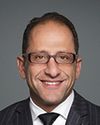Good morning, Madam Chair, and thank you for the opportunity to appear before the committee today.
My testimony today is to complement that provided by Dr. Art McDonald and perhaps provide some insight into the collaboration among so many, including those at CNL, TRIUMF, SNOLAB and the McDonald Institute.
Also, I’d be pleased to answer any questions on the role of our national laboratories and our multidisciplinary system coupled with universities, and the power of collaboration, both in times of need and, perhaps equally important, post-COVID and into the future.
However, first let me provide some background into the three Canadian national laboratory partners working alongside Dr. McDonald, our role in the project, and then a few words regarding the role of national labs and the potential future benefits of deeper integration and collaboration.
First, TRIUMF is Canada's national particle accelerator centre. It is one of Canada's premier multidisciplinary big-science laboratories and a leading subatomic physics research centre internationally. Located in Vancouver, TRIUMF is owned and operated by a consortium of 21 Canadian universities from Victoria to Halifax. I am joined online today by Dr. Jonathan Bagger, TRIUMF’s director and CEO.
Next, SNOLAB, another collaborator in the MVM project, is a leading science facility focused on discovery research in subatomic physics, largely neutrino and dark matter physics, but also other interdisciplinary fields using high-sensitivity radioisotope assay. It is located near Sudbury, Ontario, deep underground in the operational Vale Creighton nickel mine. I am joined online by Dr. Nigel Smith, the executive director of SNOLAB.
Lastly, CNL, or Canadian Nuclear Laboratories, is your nuclear science and technology laboratory. Our 3,300 employees, including over 500 of the world’s top scientists, engineers and technicians, provide unique capabilities and solutions across a wide range of industries. You may be aware of some of our active projects, including research and development into small modular reactors to provide clean, reliable energy for remote communities; cybersecurity for industrial control systems; and, together with TRIUMF, the development and production of new isotopes, including actinium-225, in our collective battle against cancer.
You may also be aware of our rich past as Atomic Energy of Canada Limited, or AECL, the inventors of the CANDU reactor technology now providing over 60% of Ontario’s clean energy, or as the home of molybdenum-99 production from the storied National Research Universal reactor, which by some estimates has provided radioisotopes to a billion patients worldwide.
As you may be aware, CNL is now operating under a government-owned, contractor-operated model. In short, CNL is a private sector company managing and operating government-owned assets and liabilities in a performance-based contract overseen by AECL, a federal Crown corporation. I should note that when the pandemic started back in mid-March, AECL, our federal Crown corporation, without reservation or hesitation instructed CNL to do whatever possible to leverage our scientific and engineering capabilities in this global fight.
That ties us back to the ventilator project and some of our discoveries. Dr. McDonald established our connection to the Italian MVM ventilator effort and engaged these Canadian national laboratories to bring their complementary capabilities together for a common objective. Each lab brought specific expertise in critical areas honed by decades of experience.
For example, TRIUMF is primarily the lead on the pre-manufacturing phase, including prototype testing, Health Canada certification, software development support and the primary interface with the manufacturers.
SNOLAB, leveraging its expertise in gaseous states, was the lead on the gas supply module and provided process mechanical support. SNOLAB also coordinated external communications requests, allowing scientists and engineers to focus solely on this vital project.
At CNL, leveraging our multidisciplinary systems approach, we provided mechanical, instrumentation, software, safety and overall engineering support. Having designed and built many reactors over the years, CNL has significant experience with formal design and development protocols, and also getting technologies out of the laboratory and into the market.
Frankly, I am inspired by the talent at all three of these national laboratories. But all our efforts would not have been possible without the tireless leadership of Dr. McDonald, whose unquestionable faith-like purpose to save lives and ability to lead in a time of crisis was key to the success of this project.
This brings me to my final point and a key discovery that I alluded to earlier. The contributions of each of these national laboratories and by all the scientists studying dark matter were not part of our day jobs. Particle physicists, sub-atomic researchers, and nuclear scientists and engineers do not routinely go to work with a mandate to invent and build mechanical ventilators for the medical community in 60 days or less.
But when needed —and most importantly, when working in combination across a broad spectrum of basic and applied disciplines—the depth and breadth of scientific and engineering excellence within Canada’s network of national facilities can be redeployed to solve the most demanding and urgent of problems. Our laboratories stand ready to be of service to the nation especially when borders are closed, international supply chains are limited, and the country needs to employ its own ingenuity and know-how to weather a storm.
With our innovative spirit and our drive to provide solutions to complex problems, Canada’s national labs are a tremendous asset to the nation. More important, when they are brought together, the opportunity is boundless and the potential to propel Canada’s prosperity is great.
We hope that the collaboration on the MVM project has helped to demonstrate the value and the potential of the national laboratory to Canada. On behalf of AECL and my national lab colleagues at TRIUMF, SNOLAB, and everyone at CNL, I can say that we’d be pleased to work with you post-COVID to further study how a network of Canada’s scientists, researchers and engineers in its totality can make Canada more innovative and internationally competitive.
Thank you for your time. We’d be pleased to answer any questions.














